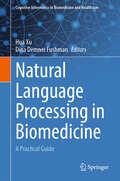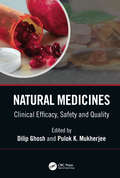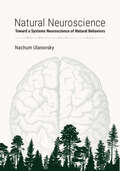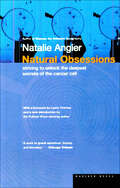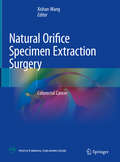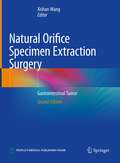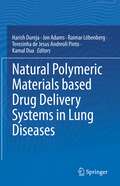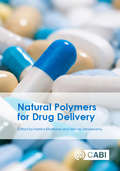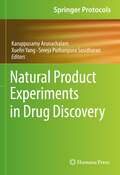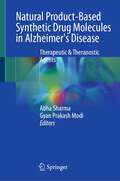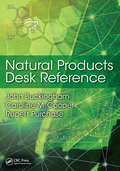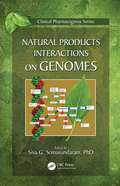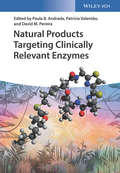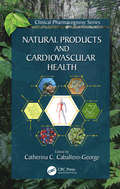- Table View
- List View
Natural Language Processing in Biomedicine: A Practical Guide (Cognitive Informatics in Biomedicine and Healthcare)
by Hua Xu Dina Demner FushmanThis textbook covers broad topics within the application of natural language processing (NLP) in biomedicine, and provides in-depth review of the NLP solutions that reveal information embedded in biomedical text. The need for biomedical NLP research and development has grown rapidly in the past two decades as an important field in cognitive informatics. Natural Language Processing in Biomedicine: A Practical Guide introduces the history of the biomedical NLP field and takes the reader through the basic aspects of NLP including different levels of linguistic information and widely used machine learning and deep learning algorithms. The book details common biomedical NLP tasks, such as named entity recognition, concept normalization, relation extraction, text classification, information retrieval, and question answering. The book illustrates the tasks with real-life use cases and introduces real-world datasets, novel machine learning and deep learning algorithms, and large language models. Relevant resources for corpora and medical terminologies are also introduced. The final chapters are devoted to discussing applications of biomedical NLP in healthcare and life sciences. This textbook therefore represents essential reading for students in biomedical informatics programs, as well as for professionals who are conducting research or building biomedical NLP systems.
Natural Medicines: Clinical Efficacy, Safety and Quality
by Dilip Ghosh Pulok K. MukherjeeGlobally, natural medicine has been considered as an important alternative to modern allopathic medicine. Although natural medicines are popular in society, only limited medicinal herbs have been scientifically evaluated for their potential in medical treatment. This book connects various aspects of the complex journey from traditional medicine to modern medicine. It provides information on topics including global regulations and regulatory hurdles, diverse nutritional challenges and potential health benefits, novel food innovations especially seed-to-clinic approaches, and future trends. FEATURES • Provides information on sustainable use of natural products in the development of new drugs and clinically validated herbal remedies • Discusses issues on evaluation and clinical aspects of herbal medicine, promotion and development, safety evaluation, metabolite profiling, biomarker analysis, formulation, and stability testing • Describes traditional uses of natural medicine through identification, isolation and structural characterization of their active components • Elucidates mechanisms of biological action, adverse effects and identification of their molecular targets of natural medicine • Multidisciplinary appeal including chemistry, pharmacology, pharmacognosy and cell and molecular biology, as well as integration with clinical medicine This book serves as an essential guide for individuals researching natural medicines, and industry employees in areas including drug development, pharmacology, natural products chemistry, clinical efficacy, ethnopharmacology, pharmacognosy, phytotherapy, phyto-technology and herbal science.
Natural Neuroscience: Toward a Systems Neuroscience of Natural Behaviors
by Nachum UlanovskyA new approach to brain research that emphasizes studying the brain under naturalistic conditions.Natural neuroscience departs from the classical reductionist approach, which emphasizes control at the expense of natural behaviors, by proposing a shift toward real-world relevance, natural behaviors, and ecological validity. In Natural Neuroscience, Nachum Ulanovsky presents the conceptual, empirical, and technological underpinnings that enabled this new field. Natural neuroscience researchers posit that when studying any brain region in any animal, whether standard mammalian species such as rodents and primates or nonstandard species, it is crucial to pursue the animal&’s natural behaviors and to consider the natural problems it needs to solve. By preventing rich natural behaviors, says Ulanovsky, we miss key aspects of brain function—and we may not even know what we miss.The author surveys recent studies that have begun to move in this direction across multiple subfields of neuroscience, including sensory, cognitive, social, and behavioral neuroscience. He discusses technological advances that are allowing the pursuit of more naturalistic experiments, including methods for recording neural activity in freely behaving, freely moving animals (e.g., wired and wireless electrophysiology and imaging); methods for manipulating neural activity in freely moving animals (e.g., wired and wireless optogenetics); and methods for quantifying the details of behavior. He makes connections across the four major scientific disciplines that focus on understanding behavior—neuroscience, behavioral ecology, ethology, and psychology—bringing them closer together, and closer to real life.
Natural Obsessions: Striving to Unlock the Deepest Secrets of the Cancer Cell
by Natalie AngierThis classic work of science writing chronicles the search for the origins of cancer—with a new introduction by the Pulitzer Prize–winning author.In Natural Obsessions, acclaimed science writer Natalie Angier holds a microscope up to the agony and ecstasy of scientific research. Angier spent close to a year observing the work of two prominent biologists—MIT’s Robert Weinberg and Michael Wigler of the Cold Spring Harbor Laboratory—as they each doggedly pursue the mysteries of the cancer cell. Delving into the drama of scientific inquiry, Angier captures life inside the lab, opening a rare window into how scientists think, feel, and behave.Originally published in 1988, this edition of Natural Obsessions includes a new introduction by Angier as well as a foreword by the physician, poet, and author Lewis Thomas.
Natural Obsessions: The Search for the Oncogene
by Lewis Thomas Natalie AngierThe discovery of these genes and their role in human malignancy has been one of the most dramatic events in biology in the late twentieth century. In this book, Angier describes scientist Bob Weinberg, his research lab, and the dozens of scientists who work towards understanding the oncogene. She describes the dynamic of the lab and its workers as well as the details of each gene experiment.
Natural Orifice Specimen Extraction Surgery
by Xishan WangWith the rapid development of surgical techniques, minimally invasive surgery has become the focal point of medical innovation technology. This book aims to introduce a comprehensive and advanced techniques of natural orifice specimen extraction surgery (NOSES). Firstly, the development process and the current status of NOSES worldwide were described. Secondly, various surgical procedures of NOSES in gastrointestinal, hepatobiliary, splenopancreatic, urogynecologic and general surgeries were elaborated, including indications and contraindications, detailed surgical steps, technical key points and operational skills. Thirdly, controversial hot topics, technical difficulties and key issues for each surgical procedure were discussed. Experience and lessons learned in practical application were also shared by experts in different fields. It is not only suitable for the gastrointestinal surgeons but also surgeons working in gastrointestinal, hepatobiliary, splenopancreatic, and urogynecologic surgeries.
Natural Orifice Specimen Extraction Surgery: Colorectal Cancer
by Xishan WangThis introduces the theoretical and practical guide of NOSES. The book introduced 10 different techniques of NOSES for colorectal neoplasms based on extensive high-quality surgical images. The first part mainly describes the development process of NOSES and the current achievements of these techniques which will provide readers a general understanding of NOSES. The second part elaborates on ten different surgical procedures specific to position of tumor location of NOSES in detail. All key technical points and operational skills regarding to NOSES are displayed by both high-quality images. The indications and contraindications are also strictly determined in this book. In addition to the elaboration of NOSES, each chapter of this book also conduct a detailed and comprehensive analysis the hot spots, technical difficulties and key issues with regard to laparoscopic surgery for colorectal cancer. This book is suitable for the colorectal cancer surgeons and doctors of general surgery.
Natural Orifice Specimen Extraction Surgery: Gastrointestinal Tumor
by Xishan WangThis book introduces readers to nine techniques for natural orifice specimen extraction surgery (NOSES) in gastric cancer and fifteen different techniques for NOSES in colorectal cancer, respectively, based on extensive high-quality surgical images. The first part mainly describes the development process of NOSES and preoperative preparation,offering readers a general understanding of NOSES. In turn, the second and third parts elaborate on the surgical procedures for gastrointestinal cancer. All key technical points and operational skills regarding NOSES are covered, and the indications and contraindications are clearly defined. In addition, the book provides a detailed and comprehensive analysis of the hot spots, technical difficulties and key issues with regard to laparoscopic surgery for gastrointestinal cancer. Accordingly, it offers an essential guide for gastrointestinal cancer surgeons and general surgeons.
Natural Orifice Translumenal Endoscopic Surgery
by Anthony N. Kalloo Ricardo Zorron Facs, Hon Jses Jacques Marescaux Hon Frcs, Facs, Hon Jses Jacques FrcsAre you interested in using NOTES to treat your patients? Do you need a multimedia tool to guide you through all aspects of clinical management? Just as laparoscopic surgery revolutionized surgical practice in the 1980's and 90's, offering genuine competition to traditional open surgery, Natural Orifice Translumenal Endoscopic Surgery (NOTES) presents a genuinely different alternative for surgeons and patients alike as we move forward in the 21st century. Advantages over laparoscopic surgery include lower anesthesia requirements, faster recovery and shorter hospital stays, avoidance of transabdominal wound infections, less immunosuppression, better postoperative pulmonary and diaphragmatic function and of course, the potential for "scarless" abdominal surgery. Combining high-level text with a superb companion website, Natural Orifice Translumenal Endoscopic Surgery (NOTES): Textbook and Video-Atlas provides you with a hands-on, in-depth and practical multimedia tool on this exciting breakthrough, to consult either on the ward or in surgery. Highlights include: Full coverage of the fundamentals of NOTES, its current clinical applications and techniques, and future perspectives Over 50 outstanding videos illustrating NOTES being performed by the experts Full-color throughout and superbly illustrated with over 250 figures Edited by global leaders and pioneers in the field, who have recruited a world-class contributor team As well being a valuable text for gastroenterologists, GI surgeons and general surgeons, Natural Orifice Translumenal Endoscopic Surgery (NOTES): Textbook and Video-Atlas will also appeal to urologists, urologic surgeons, gynecologists, gynecologic surgeons, thoracic and ENT surgeons.
Natural Polymer Drug Delivery Systems
by Saurabh BhatiaThis book describes 200 bio-polymers, including the most recent and advanced nanotechnology applications. The applications of various bio-medical and other future potential uses are covered and examined in depth. Systematic discussion of current leading natural polymers is also included.
Natural Polymeric Materials based Drug Delivery Systems in Lung Diseases
by Jon Adams Kamal Dua Raimar Löbenberg Harish Dureja Terezinha de Jesus Andreoli PintoThis book comprehensively reviews the recent developments of natural polymers for drug delivery systems in various lung disorders. The initial chapter provides a brief introduction to lung diseases with a focus on the current landscape of natural polymers and trends in understanding the disease pathology. Several chapters of the book devoted to the latest technologies and advances in drug delivery systems include practical solutions on designing more effective drug delivery systems based on natural polymers that can be used in the management of lung diseases. Further, the book presents biodegradable and bio-reducible- natural polymers- based drug delivery systems for lung diseases. Towards the end, the book examines future prospects and challenges of natural polymers-based drug delivery systems in combating lung diseases. This book is useful for phytochemists, formulation/drug delivery, biological and translational researchers and clinicians working in the field of lung disorders.
Natural Polymers for Drug Delivery
by Ram Prasad Neerupma Dhiman Monika Joshi Deepshikha Pande Katare Wong Tin Wui Anirbandeep Bose Ali Demir Sezer Erdal CevherNatural polymers have been utilized extensively in food, pharmaceuticals, cosmetics, textiles, oil drilling and paint industries. Their non-toxic and inexpensive attributes readily enhance their commercial acceptability and make them potent agents in lieu of synthetic polymers. This book explores the opportunistic utility of natural polymers in developing effective drug delivery systems and provides a comprehensive and up-to-date analysis of their source, chemical structure and mechanism of action. Covering novel polymers for drug delivery - in particular extracts from plants, microorganisms and proteins, as well as water soluble and water insoluble biodegradable polymers - it presents an encyclopaedic overview of natural polymers': - quintessential roles in binding drugs towards enhancing bioavailability - modification and derivatization for targeted delivery - role as active drugs Natural Polymers for Drug Delivery is an invaluable resource for researchers, students and industrial scientists in the fields of biochemistry, chemistry, pharmacology and food science.
Natural Polymers for Drug Delivery
by Harsha Kharkwal Srinivas JanaswamyNatural polymers have been utilized extensively in food, pharmaceuticals, cosmetics, textiles, oil drilling and paint industries. Their non-toxic and inexpensive attributes readily enhance their commercial acceptability and make them potent agents in lieu of synthetic polymers. This book explores the opportunistic utility of natural polymers in developing effective drug delivery systems and provides a comprehensive and up-to-date analysis of their source, chemical structure and mechanism of action. Covering novel polymers for drug delivery - in particular extracts from plants, microorganisms and proteins, as well as water soluble and water insoluble biodegradable polymers - it presents an encyclopaedic overview of natural polymers': - quintessential roles in binding drugs towards enhancing bioavailability - modification and derivatization for targeted delivery - role as active drugs Natural Polymers for Drug Delivery is an invaluable resource for researchers, students and industrial scientists in the fields of biochemistry, chemistry, pharmacology and food science.
Natural Product Based Drug Discovery Against Human Parasites: Opportunities and Challenges
by Archana Singh Indrakant K. Singh Brijesh Rathi Anita K. VermaThis book comprehensively reviews current and novel treatment strategies against human parasites, including protozoans and helminths, using natural products. The initial chapters summarize the conventional treatment strategies and natural-product based therapeutics against these parasites. It discusses biochemical tools and techniques for the discovery of natural product based drugs against human parasites. The book also covers the ingenious and innovative mechanisms to achieve drug resistance by the protozoan parasites and strategies to overcome the resistance. It entails mechanistic insight into the modulation of host immune responses to delay or inhibit parasite clearance and explores host-pathogen interactions that mediate immunity against subsequent parasite challenge. In turn, the volume helps in understanding the immunobiology of the parasites and tools to identify candidate vaccine antigens and novel delivery systems against the protozoan parasites. Lastly, it explores the role of advanced methods, including nanotechnology, marine bioprospecting, and microorganisms-derived biochemicals against the protozoan parasites.This book is useful for students and researchers of pharmacology, parasitology, zoology and other allied fields.
Natural Product Experiments in Drug Discovery (Springer Protocols Handbooks)
by Xuefei Yang Karuppusamy Arunachalam Sreeja Puthanpura SasidharanThis detailed volume explores a wide range of evidence-based complementary medicine and various bio-analytical techniques used to define botanical products. Collecting recent work and current developments in the field of contemporary phytomedicine as well as their future possibilities in human health care, the book includes unique contributions in the form of chapters on phytomedicine and screening biological activities explained with diverse hyphenated techniques, as well as issues related to herbal medications, such as efficacy, adulteration, safety, toxicity, regulations, and drug delivery. Written for the Springer Protocols Handbooks series, chapters feature advice from experts on how to best conduct future experiments. Extensive and practical, Natural Product Experiments in Drug Discovery serves as an ideal reference for students, professors, and researchers in universities, R&D institutes, pharmaceutical and herbal enterprises, and health organizations.
Natural Product-based Synthetic Drug Molecules in Alzheimer's Disease: Therapeutic & Theranostic Agents
by Abha Sharma Gyan Prakash ModiThis book illustrates the importance of natural products as the source for the development of novel drugs for the treatment of neurodegenerative disorders, including Alzheimer's disease. It also highlights the role of reactive oxygen species and altered metal homeostasis in the progression of Alzheimer’s disease and examines the potential of antioxidants and anti-chelating agents in the clinical intervention of neurodegenerative diseases. The book also discusses the role of neuroinflammation in the pathogenesis of Alzheimer’s disease. The chapters provide information about the drug targets, progress in the development of natural product-based therapeutics, biomarkers, fluorescent diagnostic tools, and theranostic for Alzheimer's disease. The book also provides information about the design and synthesis of natural product-based derivatives against the various targets of Alzheimer's disease including epigenetic targets and the metal dyshomeostasis hypothesis. Cutting across different disciplines, this book is a valuable source for neuroscientists, chemical biologists, pharmaceutical researchers, and synthetic biologists.
Natural Products Chemistry: Sources, Separations and Structures
by Raymond Cooper George NicolaNotoriously cumbersome to isolate and challenging to synthesize, the path of natural products to viable drugs is an arduous journey. Yet compounds isolated from nature may possess fascinating structures, biological profiles and pharmaceutical potential far greater than anything made by man. Natural Products Chemistry: Sources, Separations and
Natural Products Desk Reference
by Rupert Purchase John Buckingham Caroline M. CooperWritten by a group of experts affiliated with the prestigious Dictionary of Natural Products, this book provides a concise overview of the key structural types of natural products and their interrelationship. A structurally diverse group, ranging from simple aliphatic carbon chains to high molecular weight proteins, natural products can usually be classified into one or more groups. The text describes these major types, including flavonoids, carbohydrates, terpenoids, polyketides, and lipids, and it illustrates them with accurate chemical structures, demonstrating the biosynthetic relationships between groups. The book also covers nomenclature, stereochemistry, and ring numbering.
Natural Products Interactions on Genomes (Clinical Pharmacognosy Series)
by Siva G. SomasundaramFoods from natural products are a major contributor to contemporary dietary needs. The knowledge of interactions of specific natural products on genes is accumulating due to recent scientific advancements. Natural Products Interactions on Genomes focuses on recent developments in understanding human genome interactions with various natural products
Natural Products Isolation
by Lutfun Nahar Satyajit D. SarkerWith significant developments in the areas of chromatography and spectroscopy as well as the unique inherent chemical diversity of natural products, vital in drug research, natural products research has gained new momentum. Fully updating and adding to the previous two editions, Natural Products Isolation, Third Edition documents the latest methods and technologies for natural products isolation with a combination of all new chapters and revised and expanded classic methods. Written in the highly successful Methods in Molecular BiologyTM series format, chapters include introductions to their respective topics, lists of the necessary materials and reagents, step-by-step, readily reproducible laboratory protocols, and expert tips on troubleshooting and avoiding known pitfalls. Authoritative and up-to-date, Natural Products Isolation, Third Edition provides the substantial background information needed by budding natural product researchers as well offering an invaluable reference guide to available methodologies and techniques for the more experienced researchers.
Natural Products Targeting Clinically Relevant Enzymes
by Paula B. Andrade Patrícia Valentão David M. PereiraThe past decade has seen the reappearance of natural products as a valuable source of potent therapeutics. Here, experts on bioactive natural products cover the full spectrum of clinically relevant enzymes that are known to be targeted by natural products. Key enzymes include acetylcholine esterase, angiotensin-I-converting enzyme, cyclooxygenase, dihydrofolate reductase, phospholipase A2, respiratory complexes, and many more. By connecting the diversity of medicinal natural product sources with their potential clinical applications, this volume serves as a companion for the medicinal chemist looking for innovative small molecule compounds as well as for pharmacologist interested in the clinical effects and mode of action of herbal and traditional medicines.
Natural Products and Botanical Medicines of Iran (Natural Products Chemistry of Global Plants)
by Reza Eddin OwfiWith a high diversity of vegetation in Iran, over 8000 plant species are in existence. More than 2300 species of these plants have medicinal, edible and industrial properties, and more than 1700 species of them are endemic. Natural Products and Botanical Medicines of Iran provides an overview on important endemic plants and their usages. All results have been tabulated and key detailed information of each species is presented with background data. Features: Provides an understanding of indigenous plant-derived natural medicines of the most important medicinal plants in the region Includes discussions and critical views on the potentials and challenges for further development of the selected plants in a modern setting Details the important plants and sets out the chapters based on either taxonomy or medical use
Natural Products and Cancer Drug Discovery
by Frank E. KoehnThis volume will cover the natural products as they relate to cancer chemotherapy. The topics will include history and current status , recent launches, new clinical candidates and approved drugs directly derived from natural products, current and future cancer target opportunities for natural products, leveraging natural products as tools for new target generation , new approaches to cancer drug discovery through natural products based lead generation, and enabling technologies which leverage the unique attributes of natural products.
Natural Products and Cardiovascular Health (Clinical Pharmacognosy Series)
by Catherina Caballero GeorgeThis unique volume provides the latest information on secondary metabolites obtained from selected organisms (plants or microorganisms) that have beneficial effects in the treatment of cardiovascular diseases and an ability to offer protection against their progress. A detailed description of their source, chemistry and mechanism of action is provided, together with results of clinical studies. Here, a clear connection is made between chemical structures, in vitro studies and their clinical significance.The topic is extensive and the audience gains an understanding of the medicinal applications of these groups of secondary metabolites that have the potential to improve cardiovascular health. Features: The latest information on secondary metabolites with beneficial effects in the treatment of cardiovascular diseases. Written by an outstanding team of authors, their work provides new insights into the beneficial effects of different components present in well known plant products, evidencing their impressive cardiovascular effects. This volume discusses novel targets to screen for new drugs and the need for data obtained from clinical studies using natural products in order to better analyze the significance of in vitro experimental data. Here the reader will find a unique and timely volume with an international flavor. This book describes the source, chemistry and mechanism of action of natural products with the potential to improve cardiovascular health.
Natural Products and Human Diseases: Pharmacology, Molecular Targets, and Therapeutic Benefits (Advances in Experimental Medicine and Biology #1328)
by Amirhossein Sahebkar Thozhukat SathyapalanNatural products have a long history of use as folk medicines in several systems of traditional medicine. Extensive evidence from modern pharmacological studies has confirmed traditional applications, and unveiled the vast potential of naturally occurring compounds, particularly plant-derived phytochemicals, in the management of chronic human diseases. The past decade has witnessed a surge of findings from randomized controlled trials testifying the safety and efficacy of natural products as adjuncts or alternatives to standard-of-care medications for several illnesses. Biomolecular studies have unveiled hundreds of cellular and molecular targets for phytochemicals including key transcription factors, receptors, enzymes, hormones, neurotransmitters, cytokines, lipids, and non-coding RNAs.Extensive research on the preventative and therapeutic effects of natural products necessitates regular updating of the literature as to the developing potential roles of these compounds in different human diseases. This new book provides an overview of the current pharmacological and clinical features of natural products, and the role of phytopharmaceutical compounds in health and diseases. Chapters cover a wide scope, from cancers, to chronic and age-related disorders, and are written by leading international subject experts. Collectively, chapters will provide useful insights on the regulatory effects of phytochemicals and nutraceuticals on pathogenic molecular signatures associated with pathologies, disease biomarkers, and aging-related pathways.
